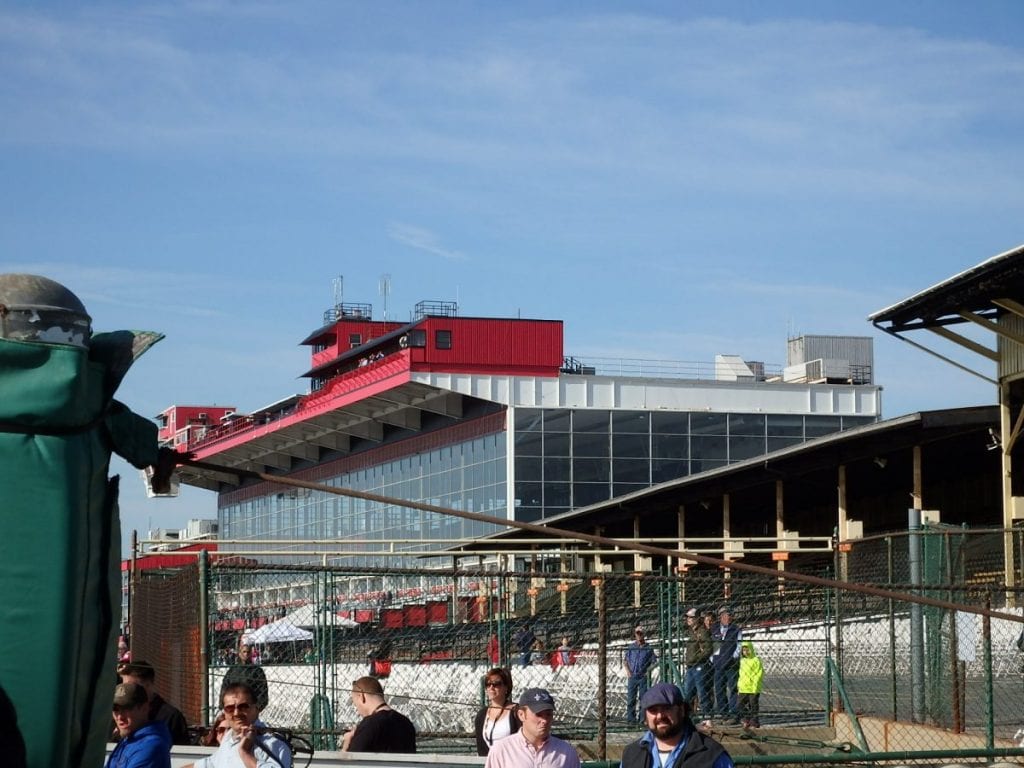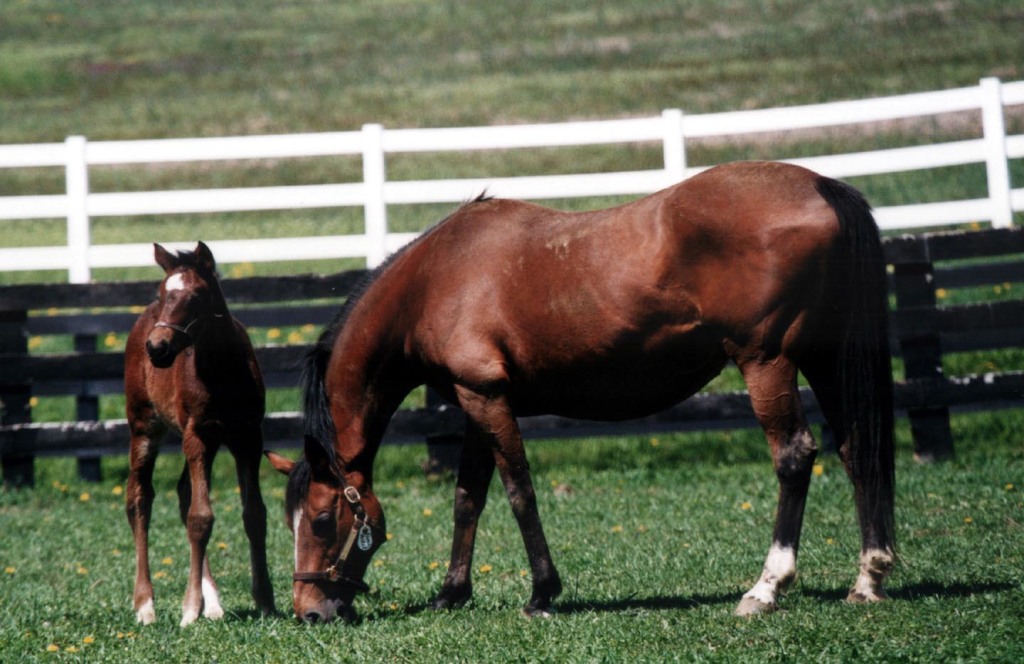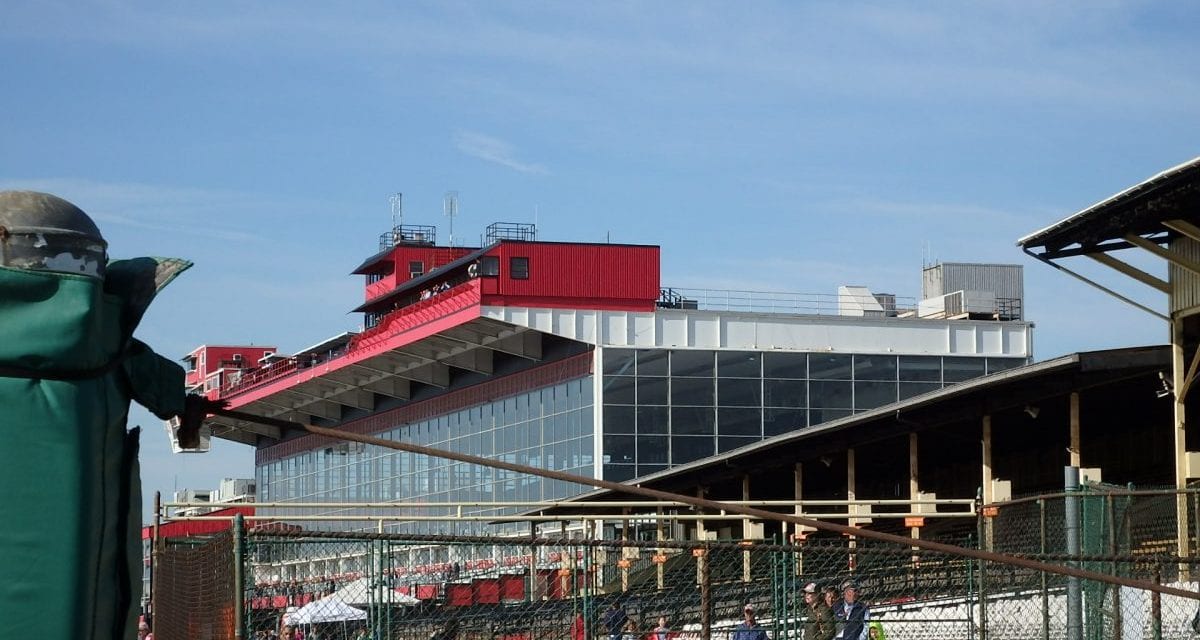
The status of Pimlico — and how that’s handled — is one challenge facing Maryland racing. Photo by The Racing Biz.
by Frank Vespe
“We won’t sleep for the next week worrying about what’s going to happen with the weather,” Stronach Group chief operating officer Tim Ritvo said last Sunday. His company owns the Maryland Jockey Club, which operates Laurel and Pimlico. “We are very confident, given a good weather day, that we’re going to put on a great Preakness weekend. There’s the potential of a really good day.”
That’s both an obvious statement – just look back to last year’s Black-Eyed Susan when rains washed the turf races onto the main track and washed away potentially millions of wagering dollars – and an indicator of the challenges facing Maryland racing.
For, while the Preakness will always be to some extent the tail that wags the Maryland racing dog, its current status – as the only profitable day in a sea of money losers – isn’t a sustainable business model.
Building a sustainable model – not for one day but for 12 months – is the challenge now facing Ritvo.
“I was engaged to come here to push the ball along,” Ritvo says. “This is a great place to walk into right now.”
Great, sure, and widely perceived to be on the upswing – yet still facing a future full of risks and potential pitfalls.
The tangible evidence of change in Maryland racing isn’t hard to find.
From the gleaming new 150-stall barn on the Laurel Park backside to the spiffed-up Sports Palace at Pimlico, horses, horsemen, and patrons alike can readily feel like a new era is at hand.
“I think we’ve left the era of gloom and doom and the sky is falling,” says trainer Ferris Allen, a trainer stabled at Laurel Park and member of the Maryland Thoroughbred Horsemen’s Association board of directors. “Now it’s like, ‘Hey, if we put on a good show, maybe people will come and watch it.’”

The health of the state’s breed industry is improving but has a ways to go. Photo by Laurie Asseo.
“Things are going good, we think,” adds Ritvo, chief operating officer of the Stronach Group, owner of the Maryland Jockey Club, which operates Laurel, Pimlico, and the Bowie Training Center. “We’re encouraged. We still believe that it’s a great market. Racing is alive and well in Maryland.”
In fact, virtually everyone in and around the state’s Thoroughbred industry speaks in similar terms. The breeding industry has begun to claw its way back from the brink of disaster. The number of mares bred in Maryland, which fell from over 2,000 in the early and mid-1990s to just 548 in 2011, has rebounded to 732 in 2014.
Purses are as high as they’ve ever been. Maiden and allowance races sport purses competitive with or better than their mid-Atlantic counterparts and – excepting those in New York – most other racing circuits. And Maryland has long maintained a more vigorous stakes program than most other mid-Atlantic tracks.
Maryland’s so-called “mile tracks,” Laurel and Pimlico, will host about 146 days of racing this year, a level that horsemen have typically said is critical to maintain.
The state – long criticized for what some perceived as relatively lax medication policies – jumped to the forefront by becoming the first to adopt fully the Racing Medication and Testing Consortium’s model uniform medication program.
And even at the all-important wagering windows, the tide has begun to turn. Export handle at Pimlico – that is, the amount of money wagered elsewhere on the Pimlico live product – was up 26 percent in April, said Maryland Jockey Club chief operating officer Sal Sinatra, a trend that he said continued through the first two weeks of May racing.
“If you’d ask me, I’d say yes, the glass is half full, it’s not half empty,” adds Bruce Quade, chairman of the Maryland Racing Commission and a man widely credited with playing a key role in facilitating the racing turnaround. He helped to broker the 10-year deal among the racetracks, horsemen, and breeders and has been the point man of a newly assertive Commission.
“I think things are looking up,” adds Cricket Goodall, executive director of the Maryland Horse Breeders Association. “They’re headed in the right direction.”
For all that, however, it’s not much harder to find potential causes for concern.
Of course, some of that is the nature of the racing beast. The horsemen who endorses the medication reform is balanced by the one who believes the rules don’t apply equally to everyone; the one who’s dubious about the new barns crosses swords with the one who loves them. ‘Twas ever thus.
The truth of the matter is that Maryland racing’s progress is real, and encouraging – but also tenuous.
Those 732 foals bred in Maryland are a far cry from the 2,210 in 1993, for example. The 146 days of live racing are less than two-thirds of what the tracks once ran. And the rising handle still has a ways to go to make much of a dent in the years of declines the tracks suffered.
And then there are the facilities. Recent weeks have seen plenty of chatter about Pimlico’s ramshackle state and its place – or, perhaps, lack thereof – in the state’s racing future.
It seems increasingly likely that that future will not include the full current roster of Laurel Park – which hosts most of the state’s live racing – Pimlico, which hosts a short Preakness meet, and the Bowie Training Center.
But which ones will survive? Will a new track come on line? And how will the widely anticipated process of consolidation take place?
“To keep two monstrous facilities going does not make any business sense,” says Ritvo. “To be honest, the next question is, if you invest hundreds of millions of dollars, is Pimlico the right place?”
Many in racing would say it is not. The track is old and built in something of a piecemeal fashion, making retrofitting difficult. Though readily accessible with both road and transit access, it sits in a city neighborhood that can make the last blocks of the journey slow going. Its parcel of land is much smaller than Laurel’s, making major change a challenge.
What’s more, Laurel has a more attractive geographic location, midway between Baltimore and Washington, DC, though access would need to be substantially improved to handle Preakness-sized crowds.
Ritvo hastens to add that the company is continuing to run models and examine different options and that it hasn’t yet made a decision on how to proceed. But, fairly or not, the widespread perception is that Pimlico is on the chopping block.
In fact, though the question of leaving Pimlico isn’t so simple as that makes it sound.
“I think in Maryland, the tradition and the history surrounding Pimlico is sort of a dynamic that goes above and beyond making a strictly, purely economic decision,” points out Quade. “There’s the historical aspects of it, the community aspects — what it means to the community, what it means to the city.
“From a regulator standpoint, the best scenario for us is to have two tracks — to have the Preakness run like it’s always run. So a two-track scenario, is what I’d vote for if I had a vote,” he adds.
Allen, from the MTHA, agrees. “I don’t think there’s much consensus for moving the Preakness anywhere,” he says. He points out numerous good places at Pimlico from which to watch a race – the outside, second-floor boxes, the revamped Sports Palace, and others – in contrast to Laurel, which he calls “so fan-unfriendly.”

Tim Ritvo. Photo provided by the Maryland Jockey Club.
Quade also points to a poltical dimension to the debate which is critical. Baltimore has political clout and no great desire to lose its signature sporting event.
“You can say that it makes all the economic sense in the world, but who is the champion for moving it?” Quade asks. “So [closing Pimlico] would be an extremely rough row to hoe.”
The political dimension takes on outsized importance because of the industry’s dependence on revenue from video lottery terminals (slot machines). Horse racing receives six percent – split in various ways – of slot machine revenues, up to a cap of $100 milllion. That money has enabled purses to rise and breeding bonuses to grow and has helped to pay for a variety of improvements to the racetracks. Without it, Quade says, the 10-year agreement among the state’s breeders, horsemen, and racetracks – and hence, the current era of good feelings – could not have happened.
“Track ownership is the one who’s under the most scrutiny,” Goodall says, particularly in Annapolis.
Were the slots money to disappear, that could throw everyone – particularly the breeders, said the MHBA’s Goodall – into a difficult situation. “Just the threat of losing the slots money, I think that’s everyone’s concern,” she says. “People want to go where they have some confidence.”
That’s especially important for breeders, whose business is inherently expensive and long range; the initial decision to breed a horse can bring three or more years of expenses before any revenue is realized. Any uncertainty, particularly in a state as dependent on VLT revenue as Maryland, can have a ripple effect whose ultimate results far outstrip the initial threat.
And that gets to the other concern to which many in the industry point.
Maryland racing, of course, exists within a larger national context, and that context is characterized by declining handle – one concern – and shrinking foal crops. It’s this latter trend that has many in the industry, including in Maryland, watching nervously.
“The biggest threat is the shrinking foal crop,” says the MJC’s Ritvo. “We need a healthy horse population.”
One part of the solution to the horse population problem is already underway: the state’s efforts to boost the attractiveness of breeding in Maryland.
New incentives give the owners and breeders of horses bred in the Free State a 30 percent bonus when those horses finish in the money in Maryland. They also provide a bonus to the Maryland-based stallion owner.
Momentum is now building to add so-called “restricted races” – that is, races restricted to horses bred (or potentially sired) in Maryland – to the Maryland racing condition book. Other than stakes, there have been very few state-bred races run in Maryland, partially because of opposition from the state’s horsemen and partially, especially in recent years, because of concerns both that there are too few Maryland-breds to sustain a restricted racing program and worries over how such a program could impact entries in other races; field size is a key factor in driving wagering handle.
“There’s people asking me about it,” says Quade. “I think restricted racing is going to be sooner than later.”
Another component of the solution could be the creation of a circuit among mid-Atlantic states. Ritvo said that talks among his company and Thoroughbred interests in Delaware and Virginia have been underway for some time, though they have been put on the back burner while Preakness preparations are underway.
“Delaware and Virginia have said they want to work with us,” he says. “We say, ‘As long as Maryland is the epicenter of the mid-Atlantic, we’re willing to work with you on a cooperative schedule.’”
While any coordination among mid-Atlantic racing interests – the region’s most racetrack-laden region – would be welcome, cooperation among Maryland, Delaware, and Virginia to some extent does not address the elephant in the room: the more than 500 live racing cards run in Pennsylvania each year. While any solution that does not involve cooperation with Pennsylvania is likely to be at best partial, Quade rightly points out that Pennsylvania would need to want to be a part of such an action.
Goodall points to that one other challenge to increasing the horse population.
“People are not as happy to pay bills and breed horses as they used to be,” she says, pointing to the many longtime breeders who have left the business in recent years. “There’s not a lot of people buying new mares to breed. You have to make the production costs recoverable.”
How to do so, however, is the question that no one has answered.
“The most effective way is to have [the costs] recoverable at the track,” she says, “to create conditions that are advantageous to breeders. There’s not a strategic plan going on.”
“I think there needs to be a conversation regarding race conditions, claiming prices [and related issues],” she adds. “Nobody’s talking about how to get new owners.”
And that, in the end, is in its way as critical to racing’s future as finding ways to raise handle.
Meanwhile, out at Old Hilltop, Black-Eyed Susan day dawned warn and sunny. Horses galloped in the dawn light. Television crews bustled around, preparing for the weekend. As the clock hit 10, fans began to enter the grounds.
Maryland’s biggest racing weekend was underway, but the forecast for Saturday, like that for the state’s racing future, remained fluid.
“We’ll see what happens Preakness weekend,” said the Maryland Jockey Club’s Sal Sinatra. “That’ll be a tell-tale.”









Excellent article. I think Tim Ritvo, like anyone in business, is doing a good job of confronting many challenges and competing interests as best he can. Not everyone will be happy a year from now, but I think that the general state of Maryland racing will be healthier.
Two minor points:
1) I would like nothing more than to see a vibrant, profitable Pimlico stay open at least from April to June so that we can continue 140 years of Preakness tradition at Old Hilltop. But I’m a realist and I think, regrettably, the time has come for the wrecking ball. That having been said, I keep hearing this line being dragged out that, “Pimlico is important to our community.” Really? Is it? The evidence of the “community” valuing Pimlico would be stellar track attendance. The next time someone outside of racing tells you how “valuable” Pimlico is to the community just ask them how many times they attend the races other than Preakness weekend. That will likely give you the sincerity of their answer.
2) A shrinking foal crop is the real issue. A QUALITY foal crop is the issue. If the 2013 foal crop was 431, what’s the glory in half of those (of the ones who do make it to the track) floundering at cheap tracks as $5K claimers? Worry less about mass-production (Chrysler) and focus on crafting a rarer but finer product (Ferrari).
Again, good article.
@HorseJeff
As someone who is about to move most of his breeding stock to MD, it would be very nice to have an out-of-state breeder bonus so that, even if I take a MD-bred to sale, and someone outside of MD buys that foal and races it in some other state, I, as the breeder, still have an opportunity to make some post-sale income from the progeny. Restricted races have cheapened the perception of the quality of the horses. Virginia has other problems, but they got the out-of-state breeder bonus right.
This is the second article that I have read where it is mentioned how much bigger Laurel is than Pimlico. How can anyone who has been there say that? Just 10 minutes from Pimlico are many fine restaurants and hotels. The same are atleasst 45 minutes from Laurel. And how come nobody mentions how unattractive Louisville is?
Thanks for checking in, April. In response to your question – it’s simply that the parcel of land on which Laurel sits is bigger than the parcel where Pimlico is. That gives the company more flexibility to do different things to increase revenue. Some of the chatter that LRL is currently more accessible than PIM is ridiculous, however.